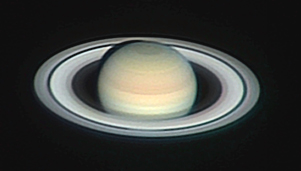

The Color Images on
this page were made through the process of combining three
separate images taken through red ,green, and blue (RGB); or cyan, magenta, and yellow (CMY) filters.
An infrared blocking filter was used in series with each
of the RGB & CMY filters. Images that are generically
referred to as LRGB or WCMY images have
been combined with a monochrome image to improve the S/N
ratio. Additional information on LRGB and WCMY imaging can
be read in the December 1998 issue of Sky and Telescope
magazine or the draft ( authored by Richard Berry, Al Kelly,
Chuck Shaw and Ed Grafton) of this article can be read
online.
An analytical analysis of the signal to noise ratio
between CMY
and RGB filtered images.
A Basic manual on acquiring and processing CCD images is being developed by Al Kelly and Ed Grafton. If you are interested in learning more about this process then be sure and read this document.
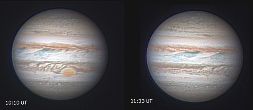
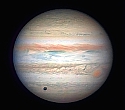
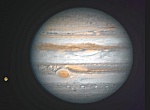
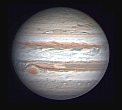
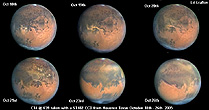 Mars Dust Storm Sequence.
Here is a sequence of images from October 18th through October
26th 2005. The Dust can be see to eventually become defuse and
spread over a large area of the Southern Hemisphere.
Mars Dust Storm Sequence.
Here is a sequence of images from October 18th through October
26th 2005. The Dust can be see to eventually become defuse and
spread over a large area of the Southern Hemisphere.
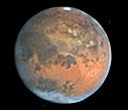 Dust Storm expands into Solas Lacus! On
October 21st, the dust storm had moved farther South and West
to Solas Lacus and deeper into Mare Erthraeum. Several dust
cores can be seen in these areas against a general backdrop of
yellow dustiness. In this image the North Polar Hood is very
prominent. The red deserts, blue polar and limb clouds and the
yellow dust storm, have conspired to configure the god of war
into a heavenly gem of beauty. C14 @ f/39 taken from Houston
Texas October 21st 2005.
Dust Storm expands into Solas Lacus! On
October 21st, the dust storm had moved farther South and West
to Solas Lacus and deeper into Mare Erthraeum. Several dust
cores can be seen in these areas against a general backdrop of
yellow dustiness. In this image the North Polar Hood is very
prominent. The red deserts, blue polar and limb clouds and the
yellow dust storm, have conspired to configure the god of war
into a heavenly gem of beauty. C14 @ f/39 taken from Houston
Texas October 21st 2005.
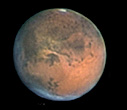 Dust Storm
Expands South into Mare Erythraeum! By October 20th, the dust storm continued its
trek to the south, spilling out of Valles Marineris. The
Yellow dust cloud can be seen as a veil of yellow with a few
concentrated cores occupying Mare Erthraeum. C14 @ f/39 Taken
from Houston Texas October 20th 2005.
Dust Storm
Expands South into Mare Erythraeum! By October 20th, the dust storm continued its
trek to the south, spilling out of Valles Marineris. The
Yellow dust cloud can be seen as a veil of yellow with a few
concentrated cores occupying Mare Erthraeum. C14 @ f/39 Taken
from Houston Texas October 20th 2005.
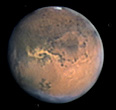 Dust Storm
Moves into Valles Marineris! By October 19th the Dust Storm had moved
intoValles Marineris. The "Grand Canyon of Mars" is a vast
canyon system that runs along the Martian equator just east of
the Tharsis region. Valles Marineris is 4000 km (2500 miles)
long and reaches depths of up to 7 km (4 miles). In this image
the dust can be seen concentrated in the valley snaking its
way through the canyons. C14 @ f/39 taken from Houston Texas
October 19th 2005.
Dust Storm
Moves into Valles Marineris! By October 19th the Dust Storm had moved
intoValles Marineris. The "Grand Canyon of Mars" is a vast
canyon system that runs along the Martian equator just east of
the Tharsis region. Valles Marineris is 4000 km (2500 miles)
long and reaches depths of up to 7 km (4 miles). In this image
the dust can be seen concentrated in the valley snaking its
way through the canyons. C14 @ f/39 taken from Houston Texas
October 19th 2005.
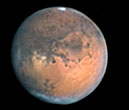 Dust Storm on Mars! On October 17th a dust storm began
brewing on Mars in Chryse Planitia, the "Plains of Gold". By
the 18th, the storm had moved south into Eos and intensified
with several dust cores presented against a backdrop of
generalized dust. C14 @ f/39 taken with a ST402 CCD from
Houston Texas October 17th and 18th 2005.
Dust Storm on Mars! On October 17th a dust storm began
brewing on Mars in Chryse Planitia, the "Plains of Gold". By
the 18th, the storm had moved south into Eos and intensified
with several dust cores presented against a backdrop of
generalized dust. C14 @ f/39 taken with a ST402 CCD from
Houston Texas October 17th and 18th 2005.
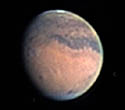
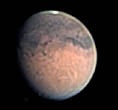
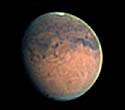
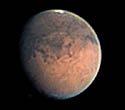
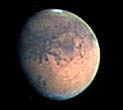
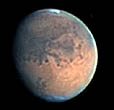
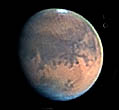
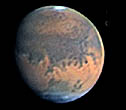
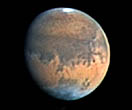
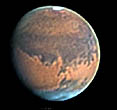
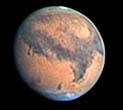
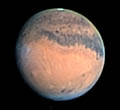
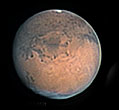 Mars
2005. The Mars apparition in 2005
brings the disk of Mars to a respectable 20 arc seconds near the
end of October. Although Mars was 25 arc seconds in diameter in
2003, the higher altitude of Mars for Northern Hemisphere
observers in 2005 makes it a very favorable apparition. In these
images from September 5th until October 9th, a full apparent
revolution of Mars is visible. The North Polar Hood is very
prominent at the bottom of the images while the South Polar Cap
is very small in response to the Southern Hemisphere summer. In
some images the NPH shows detail with brighter and lesser
condensations.
Mars
2005. The Mars apparition in 2005
brings the disk of Mars to a respectable 20 arc seconds near the
end of October. Although Mars was 25 arc seconds in diameter in
2003, the higher altitude of Mars for Northern Hemisphere
observers in 2005 makes it a very favorable apparition. In these
images from September 5th until October 9th, a full apparent
revolution of Mars is visible. The North Polar Hood is very
prominent at the bottom of the images while the South Polar Cap
is very small in response to the Southern Hemisphere summer. In
some images the NPH shows detail with brighter and lesser
condensations.
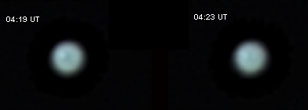
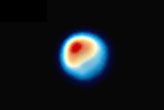
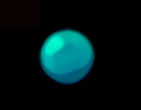 Uranus and its Moons. In these images taken July 14th, 16th, 22nd,
and 23rd, the 4 brightest moons of Uranus are visible,
Titania, Oberon, Umbreil and Areil. In the July 14th image
(left) a brighter area is noted in the northern polar regions.
The July 16th image (middle) was processed to show the
brightness variations across the globe of Uranus, again the
brightest area noted in the northern polar region. The right
images are from July 22nd and 23rd. The July 23rd image was
processed to show brightness levels across the globe of
Uranus.
Uranus and its Moons. In these images taken July 14th, 16th, 22nd,
and 23rd, the 4 brightest moons of Uranus are visible,
Titania, Oberon, Umbreil and Areil. In the July 14th image
(left) a brighter area is noted in the northern polar regions.
The July 16th image (middle) was processed to show the
brightness variations across the globe of Uranus, again the
brightest area noted in the northern polar region. The right
images are from July 22nd and 23rd. The July 23rd image was
processed to show brightness levels across the globe of
Uranus.
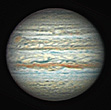
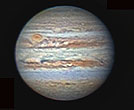 Oval BA Approaches the Great Red Spot. In these pair of images taken on March 11th
and May 20th, oval BA can be seen approaching the GRS. The GRS
and oval BA reached conjunction in July 2004.
Oval BA Approaches the Great Red Spot. In these pair of images taken on March 11th
and May 20th, oval BA can be seen approaching the GRS. The GRS
and oval BA reached conjunction in July 2004.
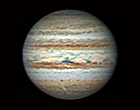
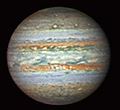
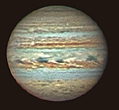 Jupiter as
Seen on April 02nd,10th and, 19th.
Jupiter as
Seen on April 02nd,10th and, 19th.
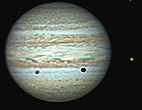 Jupiter and it's Moons IO and Ganymede. In this image, IO can be seen as the
"yellowish" star to the right. Ganymede's shadow is very
pronounced on the right side, on the northern edge of the
North Equatorial Belt ( north is down in this image). On the
lower left of the image, Ganymede can be seen in transit
across Jupiter. Ganymede appears somewhat oblate in this image
due to it's albedo features as seen against the globe of
Jupiter.
Jupiter and it's Moons IO and Ganymede. In this image, IO can be seen as the
"yellowish" star to the right. Ganymede's shadow is very
pronounced on the right side, on the northern edge of the
North Equatorial Belt ( north is down in this image). On the
lower left of the image, Ganymede can be seen in transit
across Jupiter. Ganymede appears somewhat oblate in this image
due to it's albedo features as seen against the globe of
Jupiter.
Activity on Saturn. Saturn's globe has many of the same types of features that Jupiter has. These features on Saturn are very difficult to detect since Saturn is farther away and the features contrast are much lower on Saturn. In the middle image a dark spot is seen to rotate with the globe of Saturn along the south edge of the SEB. In the right image a storm is seen in the south (up) temperate region. This storm is a new one that was first imaged on January 18th. C14 @ f/27 taken with a ST5 CCD from Houston Texas.
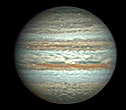
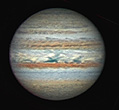 Jupiter
on January 11th and February 28th. These images of Jupiter show many festoons in
the equatorial region along with some small white ovals in the
far south (up) region. C14 @ f/27 taken with a ST5 CCD from
Houston Texas.
Jupiter
on January 11th and February 28th. These images of Jupiter show many festoons in
the equatorial region along with some small white ovals in the
far south (up) region. C14 @ f/27 taken with a ST5 CCD from
Houston Texas.
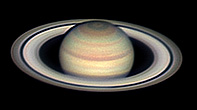 Saturn on December 7th. This image of Saturn shows several features
that are rotating with the globe of Saturn. C14 @ f/27, ST5
CCD.
Saturn on December 7th. This image of Saturn shows several features
that are rotating with the globe of Saturn. C14 @ f/27, ST5
CCD.
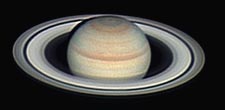 Dark Area Precedes -29 degree
Latitude Spot. Just
preceding the -29 degree spot is an elongated dark area. In
this series of images the dark area can be seen to be rotating
with the globe of Saturn. In images taken with the the HST(
see HST images
courtesy of Dr. Agustín Sánchez Lavega of the HST imaging
team), the -29 degree spot has a different appearance
depending on wavelength. Above 555nm the spot takes on an
amorphous structure. The dark area preceding the spot shows
the most contrast at 555 nm. The -29 degree white spot( blue
line) has been tracked by the HST and by several amateurs and
its drift rate is also shown.
Dark Area Precedes -29 degree
Latitude Spot. Just
preceding the -29 degree spot is an elongated dark area. In
this series of images the dark area can be seen to be rotating
with the globe of Saturn. In images taken with the the HST(
see HST images
courtesy of Dr. Agustín Sánchez Lavega of the HST imaging
team), the -29 degree spot has a different appearance
depending on wavelength. Above 555nm the spot takes on an
amorphous structure. The dark area preceding the spot shows
the most contrast at 555 nm. The -29 degree white spot( blue
line) has been tracked by the HST and by several amateurs and
its drift rate is also shown.
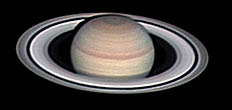 Saturn Spot Observed at -29 Degrees Latitude. A small storm is observed in this image taken
on October 19th at -29 degrees latitude, just on the edge of
the South Equatorial belt. This was the third image of this
spot obtained from Houston, the first being on October 9th.
The storm is of low contrast and at the limit of resolution
with amateur size scopes. This spot was first imaged by the
HST on August 25th and subsequent images showed that the spot
had a drift rate of -7.8 degrees per day in System III. This graphic is
courtesy of Dr. Agustín Sánchez Lavega of the HST imaging
team.
Saturn Spot Observed at -29 Degrees Latitude. A small storm is observed in this image taken
on October 19th at -29 degrees latitude, just on the edge of
the South Equatorial belt. This was the third image of this
spot obtained from Houston, the first being on October 9th.
The storm is of low contrast and at the limit of resolution
with amateur size scopes. This spot was first imaged by the
HST on August 25th and subsequent images showed that the spot
had a drift rate of -7.8 degrees per day in System III. This graphic is
courtesy of Dr. Agustín Sánchez Lavega of the HST imaging
team.
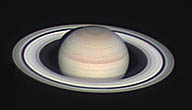 Saturn 2003-2004 Apparition. This image of Saturn was taken on October 20th
2003. Saturn is now visible in the early mourning hours
reaching it's highest point in the sky before mourning
twilight begins. Frequently the best seeing occurs in the
early mourning hours after the seeing has had a chance to
settle down. This image was taken with a ST5 CCD from Houston
Texas.
Saturn 2003-2004 Apparition. This image of Saturn was taken on October 20th
2003. Saturn is now visible in the early mourning hours
reaching it's highest point in the sky before mourning
twilight begins. Frequently the best seeing occurs in the
early mourning hours after the seeing has had a chance to
settle down. This image was taken with a ST5 CCD from Houston
Texas.
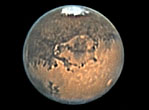 Mars
One day Before Opposition 2003. This image was taken on August 26th 2003. mars
was over 25 arc seconds in diameter, tiny by most standards
but very large for Mars in this favorable opposition. mars
presented the Solis Lacus ( lake of the Sun) region this day
from Houston Texas. This region is sometimes referred to as
the "Eye of Mars" since some see this region as resembling an
eye.
Mars
One day Before Opposition 2003. This image was taken on August 26th 2003. mars
was over 25 arc seconds in diameter, tiny by most standards
but very large for Mars in this favorable opposition. mars
presented the Solis Lacus ( lake of the Sun) region this day
from Houston Texas. This region is sometimes referred to as
the "Eye of Mars" since some see this region as resembling an
eye.
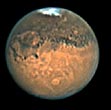 Mars Volcano Olympus Mons. The Largest Volcano in The Solar System is
Olympus Mons in the Tharsis region of Mars. It rises 15 miles
above the surrounding plane and is over 500 miles in diameter.
Here it can be seen as a round lighter area in the lower
middle portion of the image. Image taken with a C14 @ f/39 and
a ST5 CCD from Houston Texas August 21st 2003.
Mars Volcano Olympus Mons. The Largest Volcano in The Solar System is
Olympus Mons in the Tharsis region of Mars. It rises 15 miles
above the surrounding plane and is over 500 miles in diameter.
Here it can be seen as a round lighter area in the lower
middle portion of the image. Image taken with a C14 @ f/39 and
a ST5 CCD from Houston Texas August 21st 2003.
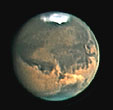
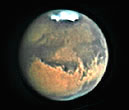 Dust Cloud Seen on Mars July 30th 2003!
This storm must have begun only hours
before the 30th image was taken ( Left image), no dust showed
on the 29th in this same region. The yellow dust cloud can be
seen in the Chryse Planitia ( the plains of gold ) and has a
distinctive horizontal V shape. The next day on the 31st (
right image) the dust had spread south ( UP ) into Eos and
Margaritifer Sinus where a concentrated dust core can be seen.
Images taken with a C14 @ f/39 with a ST5 CCD from Houston
Texas.
Dust Cloud Seen on Mars July 30th 2003!
This storm must have begun only hours
before the 30th image was taken ( Left image), no dust showed
on the 29th in this same region. The yellow dust cloud can be
seen in the Chryse Planitia ( the plains of gold ) and has a
distinctive horizontal V shape. The next day on the 31st (
right image) the dust had spread south ( UP ) into Eos and
Margaritifer Sinus where a concentrated dust core can be seen.
Images taken with a C14 @ f/39 with a ST5 CCD from Houston
Texas.
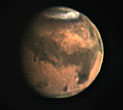
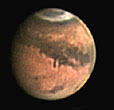
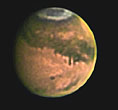
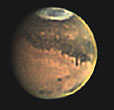
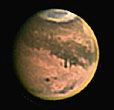
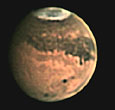
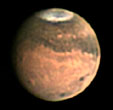 Mars July 6th through July 13th. The Dust storm that erupted on July 1st to the
South of the Hellas Basin has subsided. It does appear that
the storm did leave the atmosphere somewhat dusty as in some
of the images above there appears to be a yellow haze on the
mourning horizon. The images above, taken over a period of one
week, show that Mars seems to rotate slowly. Mars actually has
a rotation rate about 40 minutes longer than the Earth's
rotation, so Mars presents a face about 10 degrees different
from day to day when viewed at the same time each day. Images
taken from Houston Texas with a C14 and a ST5 CCD.
Mars July 6th through July 13th. The Dust storm that erupted on July 1st to the
South of the Hellas Basin has subsided. It does appear that
the storm did leave the atmosphere somewhat dusty as in some
of the images above there appears to be a yellow haze on the
mourning horizon. The images above, taken over a period of one
week, show that Mars seems to rotate slowly. Mars actually has
a rotation rate about 40 minutes longer than the Earth's
rotation, so Mars presents a face about 10 degrees different
from day to day when viewed at the same time each day. Images
taken from Houston Texas with a C14 and a ST5 CCD.
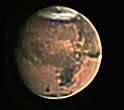
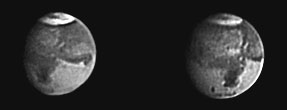 Mars Dust Cloud Erupts! In the early mourning hours of July 1st, a
small dust cloud was noticed by Don Parker and Jeff Beish in
the area just to the north of the Hellas Basin. Jeff had been
observing and sketching Mars every clear mourning and Don had
been using a ST9 CCD with his 16 inch Newtonian to capture
images. A pre-disturbance image of the area was captured by Ed
Grafton on June 28th( middle image above) which showed that no
dust was present in the area at that time. The right image was
taken on July 2nd and the dust cloud can be seen to be well
developed. The image on the left was taken on July 3rd and the
dust cloud can be seen to have advanced into the northern part
on the Hellas Basin.
Mars Dust Cloud Erupts! In the early mourning hours of July 1st, a
small dust cloud was noticed by Don Parker and Jeff Beish in
the area just to the north of the Hellas Basin. Jeff had been
observing and sketching Mars every clear mourning and Don had
been using a ST9 CCD with his 16 inch Newtonian to capture
images. A pre-disturbance image of the area was captured by Ed
Grafton on June 28th( middle image above) which showed that no
dust was present in the area at that time. The right image was
taken on July 2nd and the dust cloud can be seen to be well
developed. The image on the left was taken on July 3rd and the
dust cloud can be seen to have advanced into the northern part
on the Hellas Basin.
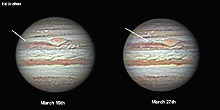
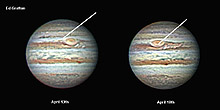 South Equatorial Belt South (SEBs) Oval
approaching GRS. A
white oval located at the Southern edge of the Jupiter's South
Equatorial Belt is being carried into the GRS Hollow by the
SEBs jet stream. This jet stream, like jet streams in the
Earths atmosphere, has a much higher velocity than the
surrounding atmospheric winds and the oval is being carried
rapidly into the GRS Hollow. In the above images, taken from
March 15th through April 18th, the oval can be seen to travel
along the South edge of the SEB and into the GRS Hollow where
it was located directly North of the GRS on April 18th. It is
not yest known if the white oval will survive it's encounter
with the GRS. Images taken with C14 @ f/27 and a ST5 CCD from
Houston Texas.
South Equatorial Belt South (SEBs) Oval
approaching GRS. A
white oval located at the Southern edge of the Jupiter's South
Equatorial Belt is being carried into the GRS Hollow by the
SEBs jet stream. This jet stream, like jet streams in the
Earths atmosphere, has a much higher velocity than the
surrounding atmospheric winds and the oval is being carried
rapidly into the GRS Hollow. In the above images, taken from
March 15th through April 18th, the oval can be seen to travel
along the South edge of the SEB and into the GRS Hollow where
it was located directly North of the GRS on April 18th. It is
not yest known if the white oval will survive it's encounter
with the GRS. Images taken with C14 @ f/27 and a ST5 CCD from
Houston Texas.
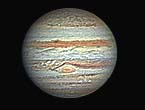 Anticyclonic White Oval AW05. The white oval AW05 in recent days has taken
on a different appearance. In the above image white oval AW05
can be seen to have a double lobed morphology contrary to it's
nearly circular morphology previously. AW05 is the white oval
just below and to the right of the GRS. This image was taken
from Houston Texas on March 15th 2003 with a C14 and ST5 CCD.
Anticyclonic White Oval AW05. The white oval AW05 in recent days has taken
on a different appearance. In the above image white oval AW05
can be seen to have a double lobed morphology contrary to it's
nearly circular morphology previously. AW05 is the white oval
just below and to the right of the GRS. This image was taken
from Houston Texas on March 15th 2003 with a C14 and ST5 CCD.
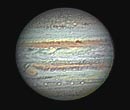
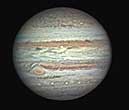 Jupiter's South South Temperate Belt (SSTB)
Anticyclonic White Ovals. In the
above image, a string
of long lived ovals occupy the area at about 40 degrees S.
latitude. In March 2002 a merging event took place between two
of the white ovals. This was the first time such an event was
witnessed directly for Jovian anticyclonic vortices located at
this latitude. An image of the event can be seen here. The above
images were taken with a C14 and ST5 on January 18th 2003 from
Houston Texas.
Jupiter's South South Temperate Belt (SSTB)
Anticyclonic White Ovals. In the
above image, a string
of long lived ovals occupy the area at about 40 degrees S.
latitude. In March 2002 a merging event took place between two
of the white ovals. This was the first time such an event was
witnessed directly for Jovian anticyclonic vortices located at
this latitude. An image of the event can be seen here. The above
images were taken with a C14 and ST5 on January 18th 2003 from
Houston Texas.
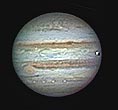 Jupiter Near Opposition. Jupiter reached it's opposite point from the
Sun relative to the Earth on February 2nd 2003. At this time
the shadow transits of Jupiter's moons are nearly directly
behind the transiting moon's disk. In this image Io can be
seen just exiting the disk of Jupiter and it's shadow can be
seen nearly directly behind it. Image taken February 1st 2003
with a C14 and ST5 CCD from Houston Texas.
Jupiter Near Opposition. Jupiter reached it's opposite point from the
Sun relative to the Earth on February 2nd 2003. At this time
the shadow transits of Jupiter's moons are nearly directly
behind the transiting moon's disk. In this image Io can be
seen just exiting the disk of Jupiter and it's shadow can be
seen nearly directly behind it. Image taken February 1st 2003
with a C14 and ST5 CCD from Houston Texas.
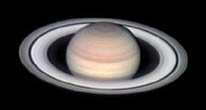 Saturn January 5th 2003 at 05:30 UT. Saturn is now a few weeks past opposition and
the globe's shadow on the rings can begin to be seen. No large
storms at -42 degrees are visible in this image but a smaller
storm at about -30 degrees may just be resolved. This image
was taken with a C14 and a ST5 CCD from Houston Texas.
Saturn January 5th 2003 at 05:30 UT. Saturn is now a few weeks past opposition and
the globe's shadow on the rings can begin to be seen. No large
storms at -42 degrees are visible in this image but a smaller
storm at about -30 degrees may just be resolved. This image
was taken with a C14 and a ST5 CCD from Houston Texas.
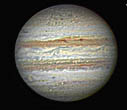
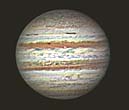
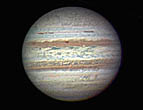 Oval BA in Jupiter's South Temperate Zone. In these two images of Jupiter, Oval BA is
visible in the lower left and lower right. This oval is a
product of two merged ovals FA and BE which combined into BA
in March of 2000. The oval BE was formed in 1998 from the two
Ovals BC and DE. These four "ancestors " of BA having endured
for over 60 years, are now all merged into oval BA. These
images of Jupiter were made with a C14 and a ST5 CCD on
January 4th and 5th 2003 from Houston Texas.
Oval BA in Jupiter's South Temperate Zone. In these two images of Jupiter, Oval BA is
visible in the lower left and lower right. This oval is a
product of two merged ovals FA and BE which combined into BA
in March of 2000. The oval BE was formed in 1998 from the two
Ovals BC and DE. These four "ancestors " of BA having endured
for over 60 years, are now all merged into oval BA. These
images of Jupiter were made with a C14 and a ST5 CCD on
January 4th and 5th 2003 from Houston Texas.
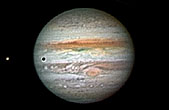 Dark Material Surrounds the Great Red Spot. On December 22nd, the GRS presented a doughnut
or bulls eye appearance. This transient feature is likely due
to the GRS sweeping up darker material into it's vortex. A
likely source of this darker material is from an eddy that
rides the jet stream that runs along the Southern border of
the SEB. As eddies sweep around the Northern edge of the GRS,
they are sometimes captured and swept back into the GRS
vortex. This image was taken from Houston Texas on December
22nd with a C14 and a ST5c CCD.
Dark Material Surrounds the Great Red Spot. On December 22nd, the GRS presented a doughnut
or bulls eye appearance. This transient feature is likely due
to the GRS sweeping up darker material into it's vortex. A
likely source of this darker material is from an eddy that
rides the jet stream that runs along the Southern border of
the SEB. As eddies sweep around the Northern edge of the GRS,
they are sometimes captured and swept back into the GRS
vortex. This image was taken from Houston Texas on December
22nd with a C14 and a ST5c CCD.
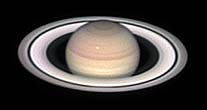 New Brighter Storm Observed on Saturn! Another in a series of Saturn Storms was seen
on December 22nd around 06:00 UT. The storm is located at a
System 3 longitude of about 330 degrees and is in the mid
southern temperate latitudes at about -42 degrees. This storm
is the largest/brightest that has been seen in a series of
storms that have presented themselves in the last few weeks.
It may be that Saturn's atmosphere has entered a more active
period since it is currently near perihelion. It is difficult
to estimate what the visibility of the storm will be in the
coming days but it will be well placed for viewing with the
spot near the central meridian just before or around 06:00 UT
on December 26th and December 30th. Excellent seeing
conditions will be needed to allow the storm to be seen
visually in 8-10inch and larger scopes.
New Brighter Storm Observed on Saturn! Another in a series of Saturn Storms was seen
on December 22nd around 06:00 UT. The storm is located at a
System 3 longitude of about 330 degrees and is in the mid
southern temperate latitudes at about -42 degrees. This storm
is the largest/brightest that has been seen in a series of
storms that have presented themselves in the last few weeks.
It may be that Saturn's atmosphere has entered a more active
period since it is currently near perihelion. It is difficult
to estimate what the visibility of the storm will be in the
coming days but it will be well placed for viewing with the
spot near the central meridian just before or around 06:00 UT
on December 26th and December 30th. Excellent seeing
conditions will be needed to allow the storm to be seen
visually in 8-10inch and larger scopes.
Commentary on Saturn's Storms/Spots. Another in a series of Saturn Storms was seen from Houston Texas on December 29th 2002. This storm is smaller than the previously observed "bright" storm on December 22nd at L3~ 330 degrees. It is located at approximately the same latitude as the other storms, at about -42 degrees, and was at about a system three longitude of L3~234 degrees on the 29th. The storm was observed by the HST on December 17th and by Damian Peach on December 18th.
Earlier in this years Saturn apparition, there was some conjecture that these small spots/storms have been prevalent all along and that higher resolution images in this years apparition have revealed them. I do not believe this to be true any longer. There was good coverage at high resolution by at least three amateurs last year; myself, D. Peach and D. Parker. None of the now seemingly ubiquitous spots were observed during the last apparition. One must conclude that these features are a new phenomenon over recent years.
The Storms seem to be short lived and appear and dissipate over a period of a few days or couple of weeks. It seems that if the storms were of longer duration, then the area at -42 degrees ( the latitude where the storms are appearing ), would be a ring of storms at this time. Damian Peach made an observation of the relatively bright December 22nd L3~330 storm on December 24th and noted that it had already faded somewhat, hinting at their volatile and limited life time.
Given the relatively short duration of the storms, it seems most likely that the storms are eruptive in nature and do not represent an organization of matter such as eddies or vortexes which would have an angular momentum that would tend to sustain them for longer periods. If the storms are eruptive in nature, they are probably convection generated.
Saturn is currently near perihelion as it is every 30 years and is receiving maximum solar radiation in the southern hemisphere. The additional solar radiation in Saturn's south temperate zone during this period may be responsible for the increase in convection currently seen as Saturn's atmosphere heats up. The solar radiation is currently at it's maximum at -25 latitude given the tilt of Saturn on it's rotational axis. The atmosphere of Saturn also goes through a "heating lag" just as the hottest days for the N. hemisphere of Earth is not at the Summer Solstice but occurs a few weeks later in July or August. This would translate into a lag on Saturn of a couple of years. If the frequency of the storms is related to perihelion or the current high solar radiation at southern latitudes, then Saturn may be even more active with eruptive storms/spots in the next year or two. In the last perihelion 30 years ago there may have been insufficient coverage at the required resolution to detect these convective events.
Oddly the area around -42 degrees seems to be the favorite choice for the storms to appear. Not considering a sub-atmospheric feature then it must be that convection storms at this latitude can more easily reach the upper atmosphere and become visible where at other latitudes the convection is somehow disrupted. Perhaps this latitude represents a "window" where atmospheric shearing forces are less and allow the convection eruptions to bubble into the upper atmosphere.
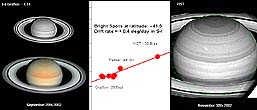 HST Views Saturn Spot. On November 30th the Hubble Space Telescope
captured an image of the spot ( convective storm ) in Saturn's
south temperate zone. The storm was first observed ( image at
left ) on September 29th 2002 from Houston Texas with a C14
and was verified by Don Parker of S. Florida on October 8th.
On the 29th it was located-42 degrees latitude and about 94
degrees SIII longitude. On November 30th the HST imaged the
spot (at much higher resolution!) and this can be seen in the
right portion of the above image. The storm has been drifting
in longitude and by November 30th, when imaged by the HST the
storm was at about 120 degrees SIII longitude.
HST Views Saturn Spot. On November 30th the Hubble Space Telescope
captured an image of the spot ( convective storm ) in Saturn's
south temperate zone. The storm was first observed ( image at
left ) on September 29th 2002 from Houston Texas with a C14
and was verified by Don Parker of S. Florida on October 8th.
On the 29th it was located-42 degrees latitude and about 94
degrees SIII longitude. On November 30th the HST imaged the
spot (at much higher resolution!) and this can be seen in the
right portion of the above image. The storm has been drifting
in longitude and by November 30th, when imaged by the HST the
storm was at about 120 degrees SIII longitude.
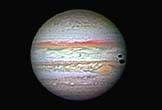 Jupiter's Moon Shadows from Callisto and IO. Shadow transits occur on a regular basis but
to see two at one time is more rare. Here can be seen the
shadow of IO and Callisto slipping off the edge of the globe.
Note how the shadows are elongated as they are cast on the
curving part of Jupiter's globe. In the center of Jupiter the
Moon Io also can be seen in transit. Note that Io shows a
phase angle just as Jupiter does. Image taken December 15th
2002 from Houston Texas with a C14 and a ST5 CCD.
Jupiter's Moon Shadows from Callisto and IO. Shadow transits occur on a regular basis but
to see two at one time is more rare. Here can be seen the
shadow of IO and Callisto slipping off the edge of the globe.
Note how the shadows are elongated as they are cast on the
curving part of Jupiter's globe. In the center of Jupiter the
Moon Io also can be seen in transit. Note that Io shows a
phase angle just as Jupiter does. Image taken December 15th
2002 from Houston Texas with a C14 and a ST5 CCD.
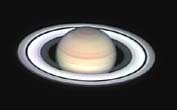 Saturn at Opposition December 17th 2002. Saturn reaches opposition every 13 months but
every 30 years Saturn is at perihelion and therefore has an
extra close path to the Earth. The rings of Saturn at this
time are at their maximum tilt and are providing their best
view. At opposition the shadow of the globe cannot be seen on
the ring system as it lies directly behind the globe. Look for
the globe shadow to become visible in the coming weeks. Two of
Saturn's moons are also visible in this image, Tethys and
Encedulas. Image taken December 15 2002 from Houston Texas
with a C14 and ST5 CCD.
Saturn at Opposition December 17th 2002. Saturn reaches opposition every 13 months but
every 30 years Saturn is at perihelion and therefore has an
extra close path to the Earth. The rings of Saturn at this
time are at their maximum tilt and are providing their best
view. At opposition the shadow of the globe cannot be seen on
the ring system as it lies directly behind the globe. Look for
the globe shadow to become visible in the coming weeks. Two of
Saturn's moons are also visible in this image, Tethys and
Encedulas. Image taken December 15 2002 from Houston Texas
with a C14 and ST5 CCD.
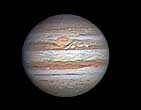
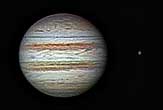
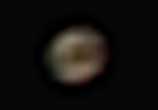 Jupiter's Red Spot and it's Moon Callisto. The left image shows an interesting dark
swirl in the GRS and many disturbed features/eddies following
in it's wake. The GRS has darkened in recent weeks and has a
more pronounced coloration than in the last few years. There
are many delicate blue festoons in the equatorial region. The
Northern segment of the EZ shows a yellow tint that comes and
goes over a period of months and was also present last year.
Several white ovals are present in the S. Temperate region.
The SEB usually shows a smooth arc flowing past the GRS but in
this image there is an indentation just to the North( below)
the GRS. This indentation represents an eddy that is sweeping
past the GRS. Sometimes these eddies are captured by the GRS
and mixed into the GRS vortex. This results in the GRS
changing its color in response to the new material captured.
The middle image of Jupiter taken 11-20-02 also shows it's
moon Callisto and the right image is an enlargement of
Callisto. The equatorial diameter of Jupiter is presently
(11-23-02) 39.6 arc seconds.
Jupiter's Red Spot and it's Moon Callisto. The left image shows an interesting dark
swirl in the GRS and many disturbed features/eddies following
in it's wake. The GRS has darkened in recent weeks and has a
more pronounced coloration than in the last few years. There
are many delicate blue festoons in the equatorial region. The
Northern segment of the EZ shows a yellow tint that comes and
goes over a period of months and was also present last year.
Several white ovals are present in the S. Temperate region.
The SEB usually shows a smooth arc flowing past the GRS but in
this image there is an indentation just to the North( below)
the GRS. This indentation represents an eddy that is sweeping
past the GRS. Sometimes these eddies are captured by the GRS
and mixed into the GRS vortex. This results in the GRS
changing its color in response to the new material captured.
The middle image of Jupiter taken 11-20-02 also shows it's
moon Callisto and the right image is an enlargement of
Callisto. The equatorial diameter of Jupiter is presently
(11-23-02) 39.6 arc seconds.
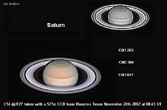
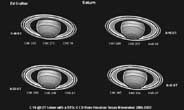 Another White Spot Discovered on Saturn! On November 19th, Damian Peach of the BAA,
imaged another white spot in the S. Temperate region of
Saturn. The spot was measured to be at L3=51.6( System 3
longitude)and at a declination of -41. On November 22nd Damian
imaged it again and it's position was measured to be at at
L3=52.6, and a declination of -41.5. This gives a preliminary
drift of +0.3degs/day vs L3. The Spot was confirmed in the
above images taken November 20th from Houston Texas. It is
somewhat unusual for these feature to show with frequency and
may be an indication that Saturn has entered a more active
period. The above Image taken with a C14 and a ST5c CCD.
Another White Spot Discovered on Saturn! On November 19th, Damian Peach of the BAA,
imaged another white spot in the S. Temperate region of
Saturn. The spot was measured to be at L3=51.6( System 3
longitude)and at a declination of -41. On November 22nd Damian
imaged it again and it's position was measured to be at at
L3=52.6, and a declination of -41.5. This gives a preliminary
drift of +0.3degs/day vs L3. The Spot was confirmed in the
above images taken November 20th from Houston Texas. It is
somewhat unusual for these feature to show with frequency and
may be an indication that Saturn has entered a more active
period. The above Image taken with a C14 and a ST5c CCD.
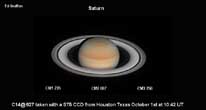
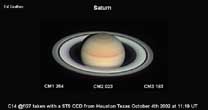
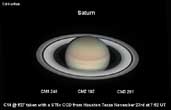 Saturn Observations. These images of Saturn were made on October
1st, 4th and November 23rd. Images taken from Houston Texas
with a C14 @f/27 and a ST5c CCD.
Saturn Observations. These images of Saturn were made on October
1st, 4th and November 23rd. Images taken from Houston Texas
with a C14 @f/27 and a ST5c CCD.
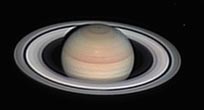
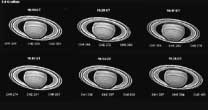 Saturn Spot Observed Again 10-07-02. Saturn's South Temperate spot was recovered on
10-07-02. It is still very low in contrast. The spot has been
measured to be at -42 degrees latitude and on 10-07 was at
about longitude 98 in system three coordinates. The spot is
drifting about +1/3 degree per day relative to system 3
longitude. There has been at least one report of the spot
being observed visually with an 11 inch scope. For the USA the
spot will be well place for observation on Friday 10-11-02 at
11:00 UT where it will be approaching the central meridian.
The second image above shows a sequence of images taken
between 10:14 UT and 11:26 UT on October 7th 2002. The spot
can be seen to be rotating in this sequence with the globe of
Saturn. Images Taken with a C14 and a ST5 CCD from Houston
Texas.
Saturn Spot Observed Again 10-07-02. Saturn's South Temperate spot was recovered on
10-07-02. It is still very low in contrast. The spot has been
measured to be at -42 degrees latitude and on 10-07 was at
about longitude 98 in system three coordinates. The spot is
drifting about +1/3 degree per day relative to system 3
longitude. There has been at least one report of the spot
being observed visually with an 11 inch scope. For the USA the
spot will be well place for observation on Friday 10-11-02 at
11:00 UT where it will be approaching the central meridian.
The second image above shows a sequence of images taken
between 10:14 UT and 11:26 UT on October 7th 2002. The spot
can be seen to be rotating in this sequence with the globe of
Saturn. Images Taken with a C14 and a ST5 CCD from Houston
Texas.
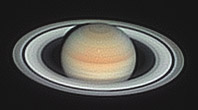
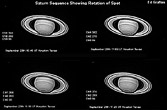
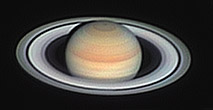 White Spot Observed in Saturn's S. Temperate
Zone! On
September 29th 2002 a small white spot was observed in the
South Temperate zone of Saturn. The spot was nearly on the
central meridian at 11:28 UT. Spots like this are rarely seen
on Saturn and observations are encouraged to monitor it. The
spot is about one arc second in size and of very low contrast.
Excellent seeing will be required to observe it and a high
contrast scope will work best. The middle sequence of four
images were take over an interval of 48 minutes from 10:40 UT
until 11:28 UT on the 29th. The spot can be seen to be
rotating with the disk of Saturn. Danny Perry constructed
an animated GIF from the above data and it can be viewed here.
The spot is located at L3=94.5 longitude and -42.9 latitude.
The right hand image was taken one day later on the 30th. In
the right hand image the spot is barely visible, mostly in the
inset image, about 40 degrees to the left from the central
longitude. Why has the spot visibility changed so much in one
day? Possible explanations are: 1) The spot is a very
transient event and is not a cyclonic storm that would usually
last for weeks or months, 2)But more likely, the spot is most
visible when on the central longitude. When viewed from an
angled perspective it is likely that the spot is being
obscured by high level haze in the upper reaches of Saturn's
atmosphere. This high level haze layer is the reason that
Saturn does not display the cornucopia of disk detail that
Jupiter shows. Images taken with a C14 @ f/27 with a ST5 CCD
from Houston Texas September 29th and 30th 2002.
White Spot Observed in Saturn's S. Temperate
Zone! On
September 29th 2002 a small white spot was observed in the
South Temperate zone of Saturn. The spot was nearly on the
central meridian at 11:28 UT. Spots like this are rarely seen
on Saturn and observations are encouraged to monitor it. The
spot is about one arc second in size and of very low contrast.
Excellent seeing will be required to observe it and a high
contrast scope will work best. The middle sequence of four
images were take over an interval of 48 minutes from 10:40 UT
until 11:28 UT on the 29th. The spot can be seen to be
rotating with the disk of Saturn. Danny Perry constructed
an animated GIF from the above data and it can be viewed here.
The spot is located at L3=94.5 longitude and -42.9 latitude.
The right hand image was taken one day later on the 30th. In
the right hand image the spot is barely visible, mostly in the
inset image, about 40 degrees to the left from the central
longitude. Why has the spot visibility changed so much in one
day? Possible explanations are: 1) The spot is a very
transient event and is not a cyclonic storm that would usually
last for weeks or months, 2)But more likely, the spot is most
visible when on the central longitude. When viewed from an
angled perspective it is likely that the spot is being
obscured by high level haze in the upper reaches of Saturn's
atmosphere. This high level haze layer is the reason that
Saturn does not display the cornucopia of disk detail that
Jupiter shows. Images taken with a C14 @ f/27 with a ST5 CCD
from Houston Texas September 29th and 30th 2002.
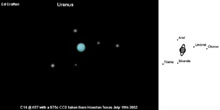 The Moons of Uranus. The Moons of Uranus can present quite a
challenge to observe with amateur size scopes. Although Uranus
has many moons only a few are bright enough to see visually
and it will take a clear dark and steady sky with a good size
scope to be successful. One's best bet is the moon Titiania
with a diameter of about 1600km and a magnitude of about 13.5.
The next two brightest moons are Oberon and Ariel at about
magnitude 14. The "bright" glare from the planet will make it
more difficult than these magnitudes indicate. Umbreil is next
at about magnitude 14.5. The last of the brighter moons is
Miranda. It's magnitude of about 16 makes it all but
impossible to spot except in a 20-30 inch scope under perfect
conditions. This image is a composite of two images, one to
capture the disk of Uranus and the other to capture the moons.
The Moons of Uranus. The Moons of Uranus can present quite a
challenge to observe with amateur size scopes. Although Uranus
has many moons only a few are bright enough to see visually
and it will take a clear dark and steady sky with a good size
scope to be successful. One's best bet is the moon Titiania
with a diameter of about 1600km and a magnitude of about 13.5.
The next two brightest moons are Oberon and Ariel at about
magnitude 14. The "bright" glare from the planet will make it
more difficult than these magnitudes indicate. Umbreil is next
at about magnitude 14.5. The last of the brighter moons is
Miranda. It's magnitude of about 16 makes it all but
impossible to spot except in a 20-30 inch scope under perfect
conditions. This image is a composite of two images, one to
capture the disk of Uranus and the other to capture the moons.
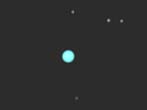 The Gas Giant Uranus and it's moons. Uranus has a diameter of about 48,000 km but
due to it's great distance from Earth, it displays a disk of
only about 3.8 arc seconds. Uranus is about 2.8 million km
from the sun and it takes 84 years for it to make one orbit.
The four moons in this image range in brightness from about
magnitude 14 to about magnitude 15 making them quite a
challenge for for amateur astronomers to observe visually.
This image of Uranus was made with a ST5c and a C14 @ f/27.
Taken from Houston Texas 7/06/02 at 10:01 UT.
The Gas Giant Uranus and it's moons. Uranus has a diameter of about 48,000 km but
due to it's great distance from Earth, it displays a disk of
only about 3.8 arc seconds. Uranus is about 2.8 million km
from the sun and it takes 84 years for it to make one orbit.
The four moons in this image range in brightness from about
magnitude 14 to about magnitude 15 making them quite a
challenge for for amateur astronomers to observe visually.
This image of Uranus was made with a ST5c and a C14 @ f/27.
Taken from Houston Texas 7/06/02 at 10:01 UT.
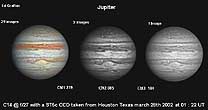 White
Ovals Merging. At 50degrees South latitude ( just below the
great red spot in this image) a pair of tiny ovals are in the
process of merging and can barely be detected as separate in
this high resolution image. From this and other images it
appears that the two ovals circled one another in a spiral
"dance" as they began converging. Taken with a C14 @ f/27 and
a ST5c CCD from Houston Texas on March 28th 2002.
White
Ovals Merging. At 50degrees South latitude ( just below the
great red spot in this image) a pair of tiny ovals are in the
process of merging and can barely be detected as separate in
this high resolution image. From this and other images it
appears that the two ovals circled one another in a spiral
"dance" as they began converging. Taken with a C14 @ f/27 and
a ST5c CCD from Houston Texas on March 28th 2002.
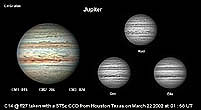 Making
Color Planetary Images. The
Planetary images on this page were made through a process (
called LRGB ) of taking 4 separate images and combining them
into a single color composite. Red green and blue filters were
used to gather the color information. The images through these
filters yields the brightness of the object at 600-700 nano
meters wavelength ( red ) , 500-600 nm ( green ) and 400-500
nm ( blue ). A separate no filtered image was used to
produce a high signal to noise image at 400-1000nm wavelength.
Combining these four images yields the color composite.
Making
Color Planetary Images. The
Planetary images on this page were made through a process (
called LRGB ) of taking 4 separate images and combining them
into a single color composite. Red green and blue filters were
used to gather the color information. The images through these
filters yields the brightness of the object at 600-700 nano
meters wavelength ( red ) , 500-600 nm ( green ) and 400-500
nm ( blue ). A separate no filtered image was used to
produce a high signal to noise image at 400-1000nm wavelength.
Combining these four images yields the color composite.
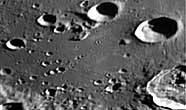 Moon Crater Clavius. This crater is one of the largest on the Moon.
It has many smaller "crater-lets" on its floor. It is a
challenge to see how many can be resolved with an amateur
telescope. Test your scope/skies/eyes by seeing how many you
can resolve the next time it is well placed for observation.
Taken with a C14 @ f/27 and a ST5c CCD from Houston Texas on
March 24th 2002.
Moon Crater Clavius. This crater is one of the largest on the Moon.
It has many smaller "crater-lets" on its floor. It is a
challenge to see how many can be resolved with an amateur
telescope. Test your scope/skies/eyes by seeing how many you
can resolve the next time it is well placed for observation.
Taken with a C14 @ f/27 and a ST5c CCD from Houston Texas on
March 24th 2002.
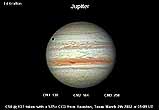 Oval Shadow from Ganymede. Being well past opposition, Jupiter is currenty about 41 arc seconds in
diameter ( it reached a maximum in early January at about 47
arc seconds) and shrinking in apparent size daily. Ganymede's
shadow can be seen about to exit the globe of Jupiter and is
seen oblong by the foreshortening in longitude. The STZ is
currently very nondescript at this CM and the STB belt is
somewhat faded in this region. The NTB is very prominent and
presents small rifts and spots along it's coarse. Several
prominent festoons are present in the EZ. Barge B-4 is seen
just above (south) of a rift in the NEB having already passed
the CM. This image of Jupiter was taken with a C14 @ f/27 and
a ST5c CCD from Houston, Texas on 03-07-02 2002 01:09 UT.
Oval Shadow from Ganymede. Being well past opposition, Jupiter is currenty about 41 arc seconds in
diameter ( it reached a maximum in early January at about 47
arc seconds) and shrinking in apparent size daily. Ganymede's
shadow can be seen about to exit the globe of Jupiter and is
seen oblong by the foreshortening in longitude. The STZ is
currently very nondescript at this CM and the STB belt is
somewhat faded in this region. The NTB is very prominent and
presents small rifts and spots along it's coarse. Several
prominent festoons are present in the EZ. Barge B-4 is seen
just above (south) of a rift in the NEB having already passed
the CM. This image of Jupiter was taken with a C14 @ f/27 and
a ST5c CCD from Houston, Texas on 03-07-02 2002 01:09 UT.
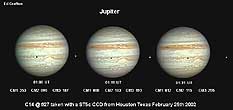 Oval BA Eases Past GRS. The oval BA appears as though it will ease
past the GRS and remain intact and has now passed the central
longitude of the GRS. In the next few weeks it is likely that
the S. Trop. disturbance will be revived by the wake of BA
passing the GRS. The NEB has a pronounced rift and
several white spots are visible at about 41 degrees south
longitude just below the GRS. The equatorial region has
several festoons that are visible and much turbulence is seen
following the GRS in the SEB. Images taken 02-25-2002 with a
C14 @ f/27 and a ST5C CCD from Houston, Texas.
Oval BA Eases Past GRS. The oval BA appears as though it will ease
past the GRS and remain intact and has now passed the central
longitude of the GRS. In the next few weeks it is likely that
the S. Trop. disturbance will be revived by the wake of BA
passing the GRS. The NEB has a pronounced rift and
several white spots are visible at about 41 degrees south
longitude just below the GRS. The equatorial region has
several festoons that are visible and much turbulence is seen
following the GRS in the SEB. Images taken 02-25-2002 with a
C14 @ f/27 and a ST5C CCD from Houston, Texas.
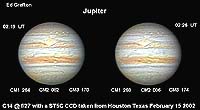
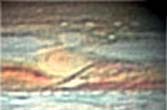 Oval BA and the Great Red Spot. Oval BA is a long lived white oval that has
survived for decades( the Red Spot has been around for several
hundred years or more). Here oval BA can be seen just above
the Great Red spot. The two have been approaching one another
and can be seen further apart in an image taken
in December. It is unknown weather BA will survive this close
encounter and it is of much interest to planetary scientist as
to the final outcome of this Jovian rendezvous. The
above images were taken February 15th 2002 from Houston, Texas
with a C14 and a ST5C CCD at f/27.
Oval BA and the Great Red Spot. Oval BA is a long lived white oval that has
survived for decades( the Red Spot has been around for several
hundred years or more). Here oval BA can be seen just above
the Great Red spot. The two have been approaching one another
and can be seen further apart in an image taken
in December. It is unknown weather BA will survive this close
encounter and it is of much interest to planetary scientist as
to the final outcome of this Jovian rendezvous. The
above images were taken February 15th 2002 from Houston, Texas
with a C14 and a ST5C CCD at f/27.
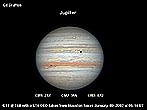
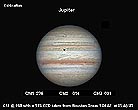 South Tropical Belt (STB) Grows. In early November the STB began to emerge from
the preceding edge of the great red spot (GRS) and extended to
a brown oval at the same latitude( click here for a
Nov. 18th image showing the STB extending from the GRS to
the brown oval). The STB growth became arrested in
November and its growth remained static until late December.
In late December the STB began growing again and has elongated
well past the brown oval and can be seen faintly all the way
around the globe in the above images. The shadow in the above
images is from Io. Io is directly adjacent to and just to left
of the shadow. Note that the polar regions of Io show as dark
red in the above images. Images taken with a C14 and a ST6 CCD
from Houston Texas 01-04-2002 UT.
South Tropical Belt (STB) Grows. In early November the STB began to emerge from
the preceding edge of the great red spot (GRS) and extended to
a brown oval at the same latitude( click here for a
Nov. 18th image showing the STB extending from the GRS to
the brown oval). The STB growth became arrested in
November and its growth remained static until late December.
In late December the STB began growing again and has elongated
well past the brown oval and can be seen faintly all the way
around the globe in the above images. The shadow in the above
images is from Io. Io is directly adjacent to and just to left
of the shadow. Note that the polar regions of Io show as dark
red in the above images. Images taken with a C14 and a ST6 CCD
from Houston Texas 01-04-2002 UT.
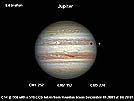
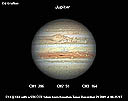 North
and South Equatorial Belt Disturbances. The North and South Equatorial belts on
Jupiter are currently undergoing a period of high activity
with many complex features. Images taken 12-19-2001 and
12-21-2001 with a C14 and a ST6 CCD from Houston, Texas.
North
and South Equatorial Belt Disturbances. The North and South Equatorial belts on
Jupiter are currently undergoing a period of high activity
with many complex features. Images taken 12-19-2001 and
12-21-2001 with a C14 and a ST6 CCD from Houston, Texas.
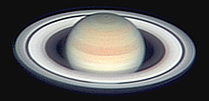 Saturn's Crepe Ring. The Crepe ring is the inner most ring seen in
this image. It is very tenuous and is semi transparent. The
globe of Saturn can be seen through the rings in this image
and it gives a dusky quality to the globe. The Crepe ring was
first discovered in 1839 by J.Galle with a 9 inch refractor.
The Crepe ring seems to vary somewhat in contrast but should
be visible under good conditions with an 8 inch scope. This
image was taken under exceptionally good seeing conditions
from Houston Texas November 19 2001 with a ST6 CCD and a C14.
Saturn's Crepe Ring. The Crepe ring is the inner most ring seen in
this image. It is very tenuous and is semi transparent. The
globe of Saturn can be seen through the rings in this image
and it gives a dusky quality to the globe. The Crepe ring was
first discovered in 1839 by J.Galle with a 9 inch refractor.
The Crepe ring seems to vary somewhat in contrast but should
be visible under good conditions with an 8 inch scope. This
image was taken under exceptionally good seeing conditions
from Houston Texas November 19 2001 with a ST6 CCD and a C14.
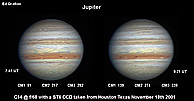
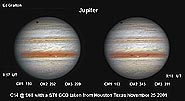 Jupiter's
Blue Festoons. In recent
weeks, Jupiter's atmosphere has become more active and the
blue festoons have returned to the equatorial zone. The
festoons can change their shape rapidly and in these image
seemed to be anchored to the NEB which has also been very
active in the last few weeks. It is not known if the increased
activity of the NEB is related to the festoons becoming more
prominent. Images taken on 11-18-01 and 11-25-01 from Houston
Texas with a ST6 CCD and a C14.
Jupiter's
Blue Festoons. In recent
weeks, Jupiter's atmosphere has become more active and the
blue festoons have returned to the equatorial zone. The
festoons can change their shape rapidly and in these image
seemed to be anchored to the NEB which has also been very
active in the last few weeks. It is not known if the increased
activity of the NEB is related to the festoons becoming more
prominent. Images taken on 11-18-01 and 11-25-01 from Houston
Texas with a ST6 CCD and a C14.
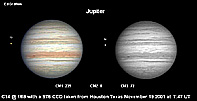 Emergence of South Tropical belt. In early November the STB began to emerge from
the preceding edge of the great red spot ( which can just be
seen coming around in the upper right of this image) and now
extends to a brown oval at the same latitude. Last year a
similar brown oval ended when it merged with the GRS hollow.
The extension of the STB from the red spot happens about once
a year. Also note Io's orange appearance in this image. Image
taken form Houston Texas with a ST6 CCD and a C14 on November
18th 2001.
Emergence of South Tropical belt. In early November the STB began to emerge from
the preceding edge of the great red spot ( which can just be
seen coming around in the upper right of this image) and now
extends to a brown oval at the same latitude. Last year a
similar brown oval ended when it merged with the GRS hollow.
The extension of the STB from the red spot happens about once
a year. Also note Io's orange appearance in this image. Image
taken form Houston Texas with a ST6 CCD and a C14 on November
18th 2001.
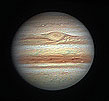
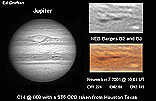
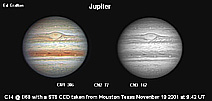 North Equatorial Belt Barges B2 and B3 Collide. Jupiter's features are constantly changing and
moving with respect to one another. Dark streaks seen in the
belts are called barges. The barges B2 and B3 seen in the NEB(
the bottom main belt on the right side) were about 15 degrees
apart as seen in an image (click here)
taken taken 10-02-2001. In the left two images above taken on
11-07-01 the barges have collided and are in the process of
merging into one feature. In the right image taken on
11-19-01, it can be seen that the barges have merged. Images
taken form Houston Texas with a ST6 CCD and a C14.
North Equatorial Belt Barges B2 and B3 Collide. Jupiter's features are constantly changing and
moving with respect to one another. Dark streaks seen in the
belts are called barges. The barges B2 and B3 seen in the NEB(
the bottom main belt on the right side) were about 15 degrees
apart as seen in an image (click here)
taken taken 10-02-2001. In the left two images above taken on
11-07-01 the barges have collided and are in the process of
merging into one feature. In the right image taken on
11-19-01, it can be seen that the barges have merged. Images
taken form Houston Texas with a ST6 CCD and a C14.
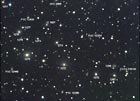 Abell Galaxy Cluster 426. This
galaxy Cluster is located at about RA 3hrs 20min and
Declination +41.5. Located in the constellation Perseus, this
cluster will be a challenge to observe in amateur sizes
scopes. A dark sky and a 12-16 inch scope will reveal most of
the galaxies in this cluster. The labeled galaxies range in
brightness from about magnitude 13 to magnitude 16. Image
taken with a 8 inch f/4 newt. with a ST237 CCD on 11-03-2001
from Houston Texas. L= 40 min., R=G=B= 15 min.
Abell Galaxy Cluster 426. This
galaxy Cluster is located at about RA 3hrs 20min and
Declination +41.5. Located in the constellation Perseus, this
cluster will be a challenge to observe in amateur sizes
scopes. A dark sky and a 12-16 inch scope will reveal most of
the galaxies in this cluster. The labeled galaxies range in
brightness from about magnitude 13 to magnitude 16. Image
taken with a 8 inch f/4 newt. with a ST237 CCD on 11-03-2001
from Houston Texas. L= 40 min., R=G=B= 15 min.
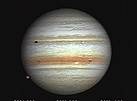 Jupiter Satellite Eclipses and Transits. Jupiter's moons frequently pass in front of
and behind Jupiter as seen from Earth. These events are
interesting to observe and can be viewed with a 90mm or larger
scope. In this image the moon Io is in transit across Jupiter
and it's shadow can be seen on the south equatorial belt. At
the same time Jupiter's moon Ganymede was just disappearing
behind Jupiter and is seen partially eclipsed on the lower
left portion of the globe.
Jupiter Satellite Eclipses and Transits. Jupiter's moons frequently pass in front of
and behind Jupiter as seen from Earth. These events are
interesting to observe and can be viewed with a 90mm or larger
scope. In this image the moon Io is in transit across Jupiter
and it's shadow can be seen on the south equatorial belt. At
the same time Jupiter's moon Ganymede was just disappearing
behind Jupiter and is seen partially eclipsed on the lower
left portion of the globe.
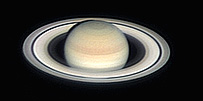 Saturn's Enke Division and B Ring Intensity
Minima. Saturn's rings
are composed of many sets of rings. Most are aware of the main
three( rings A, B & C ) but the ring system has much
structure besides the main three. In this image, many
intensity minima can be seen as faint low contrast "divisions"
in the B ring ( the wide ring). In the A ring ( outermost ring
), Saturn's Enke division can be seen as a fine line about
2/3rds on the way out at the rings ansa. The Enke division is
a real challenge to see visually in any size scope and takes
fine optics, keen observing skills and a very steady
atmosphere to detect . Image taken from Houston Texas with a
C14 and a ST6 CCD @ f/68 on 10-18-01.
Saturn's Enke Division and B Ring Intensity
Minima. Saturn's rings
are composed of many sets of rings. Most are aware of the main
three( rings A, B & C ) but the ring system has much
structure besides the main three. In this image, many
intensity minima can be seen as faint low contrast "divisions"
in the B ring ( the wide ring). In the A ring ( outermost ring
), Saturn's Enke division can be seen as a fine line about
2/3rds on the way out at the rings ansa. The Enke division is
a real challenge to see visually in any size scope and takes
fine optics, keen observing skills and a very steady
atmosphere to detect . Image taken from Houston Texas with a
C14 and a ST6 CCD @ f/68 on 10-18-01.
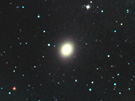 Elliptical Galaxy M32 in Andromeda. This small galaxy is one of four companions to
the great galaxy M31 in Andromeda. This galaxy is about 2400
light years across and about 3 arc minutes in apparent size.
It is 9th magnitude and should be visible in a four inch scope
from a dark location. This image was taken from Houston, Texas
with an 8 inch f/4 Newtonian and a ST237 CCD on 10/16/01. L=20
minutes, R=G=B=10 minutes.
Elliptical Galaxy M32 in Andromeda. This small galaxy is one of four companions to
the great galaxy M31 in Andromeda. This galaxy is about 2400
light years across and about 3 arc minutes in apparent size.
It is 9th magnitude and should be visible in a four inch scope
from a dark location. This image was taken from Houston, Texas
with an 8 inch f/4 Newtonian and a ST237 CCD on 10/16/01. L=20
minutes, R=G=B=10 minutes.
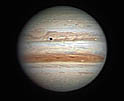 The planet Jupiter. The planet Jupiter is one of the most
interesting objects of the solar system to observe. In this
image, the shadow of the moon IO can be seen as a dark spot
near the great red spot. Io can be seen as a white dot in the
upper of the two major cloud belts (South Equatorial Belt) on
the right hand side. These shadow/satellite transits happen
quite often and can easily be observed with a 3 inch
telescope. The two major cloud belts can be seen in a 60mm
scope and smaller belts become visible in a 6 in. scope under
good seeing conditions. In this image several blue festoons
can be seen between the two major cloud belts. This image was
taken on 10-02-01 at 10:58 UT with a ST6 and a C14 at f/66
using a 10mm plossel eyepiece for projection. L = 8 x .3
seconds, R = G = B = 2 x .6 seconds.
The planet Jupiter. The planet Jupiter is one of the most
interesting objects of the solar system to observe. In this
image, the shadow of the moon IO can be seen as a dark spot
near the great red spot. Io can be seen as a white dot in the
upper of the two major cloud belts (South Equatorial Belt) on
the right hand side. These shadow/satellite transits happen
quite often and can easily be observed with a 3 inch
telescope. The two major cloud belts can be seen in a 60mm
scope and smaller belts become visible in a 6 in. scope under
good seeing conditions. In this image several blue festoons
can be seen between the two major cloud belts. This image was
taken on 10-02-01 at 10:58 UT with a ST6 and a C14 at f/66
using a 10mm plossel eyepiece for projection. L = 8 x .3
seconds, R = G = B = 2 x .6 seconds.
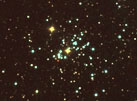
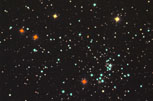 The Double Cluster in Perseus. NGC869 ( left ) and NGC884 ( right ) make up
this famous pair of of open clusters called the
"The Double Cluster". A beautiful site even in a small
telescope, each cluster is about 35 arc minutes in size and
are separated by about one degree. The double cluster is
visible to the eye under a dark sky and is about 7000 light
years from Earth. There are many spectral class A and B stars
( blue ) and also some spectral class M red giants in these
clusters. These images were taken with an 8 inch f/4 newt and
a ST237 CCD from Houston Texas on 9/27/01 and 9/29/01.
The Double Cluster in Perseus. NGC869 ( left ) and NGC884 ( right ) make up
this famous pair of of open clusters called the
"The Double Cluster". A beautiful site even in a small
telescope, each cluster is about 35 arc minutes in size and
are separated by about one degree. The double cluster is
visible to the eye under a dark sky and is about 7000 light
years from Earth. There are many spectral class A and B stars
( blue ) and also some spectral class M red giants in these
clusters. These images were taken with an 8 inch f/4 newt and
a ST237 CCD from Houston Texas on 9/27/01 and 9/29/01.
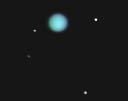 The Planet Uranus and it's Moons.
A member of the gas giants, Uranus has a
diameter of about 48,000 km but due to it's distance, it
displays a disk of only 4 arc seconds. Uranus is about 2.8
million km from the sun and it takes 84 years for it to make
one trip around the sun. The four moons in this image range in
brightness from magnitude 14.0 to 15.3 making them quite a
challenge for for amateur astronomers to observe visually.
This image of Uranus was made with a ST6 and a C14 @ f/60.
Taken from Houston Texas 8/22/01 at 6:49 UT.
The Planet Uranus and it's Moons.
A member of the gas giants, Uranus has a
diameter of about 48,000 km but due to it's distance, it
displays a disk of only 4 arc seconds. Uranus is about 2.8
million km from the sun and it takes 84 years for it to make
one trip around the sun. The four moons in this image range in
brightness from magnitude 14.0 to 15.3 making them quite a
challenge for for amateur astronomers to observe visually.
This image of Uranus was made with a ST6 and a C14 @ f/60.
Taken from Houston Texas 8/22/01 at 6:49 UT.
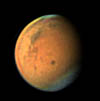 More dust on Mars. The dust from the recent storms has spread to
cover nearly the entire globe of Mars. From this image one can
see that new dust storms are forming. It is not likely that
the dust will settle from the atmosphere anytime soon as the
atmospheric dust is being replenished from the new storms. In
this image the latest dust storm can be see in the left
portion of the image as a brighter area. Image taken 7-31-01
from Houston, Texas with a C14 and a ST6 CCD.
More dust on Mars. The dust from the recent storms has spread to
cover nearly the entire globe of Mars. From this image one can
see that new dust storms are forming. It is not likely that
the dust will settle from the atmosphere anytime soon as the
atmospheric dust is being replenished from the new storms. In
this image the latest dust storm can be see in the left
portion of the image as a brighter area. Image taken 7-31-01
from Houston, Texas with a C14 and a ST6 CCD.
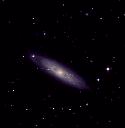 L/RGB image of galaxy NGC7184 in Aquarius. Made
from images taken by Al Kelly and Ed Grafton on 7/20/01 with
an SBIG ST-9E and 32" f4 Newtonian from Danciger, Texas. Six
240-second sub-exposures in white (IR blocked only), two
240-second sub-exposures in red, three 240-second
sub-exposures in green, and three 240-second sub exposures in
blue were processed in AIP4WIN.
L/RGB image of galaxy NGC7184 in Aquarius. Made
from images taken by Al Kelly and Ed Grafton on 7/20/01 with
an SBIG ST-9E and 32" f4 Newtonian from Danciger, Texas. Six
240-second sub-exposures in white (IR blocked only), two
240-second sub-exposures in red, three 240-second
sub-exposures in green, and three 240-second sub exposures in
blue were processed in AIP4WIN.
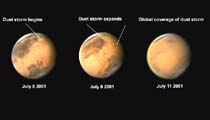 Mars Dust Storm. A global dust storm on Mars began in late June
and by July 11th had spread to nearly the entire globe. In
this sequence, the spread of the dust storm in the hemisphere
facing the USA from July 5th through July 11th can be seen. In
the left ( July 5th ) image the storm began near Solas Lacus.
In the middle image (July 8th) the storm is seen to have
spread across about one fourth of the hemisphere that is
facing the USA. By July 11th ( right image ), the storm had
spread across most of the remainder of the hemisphere making
nearly all the albedo features very weak. Although dust storms
are not unusual on Mars, this storm is one of the earliest and
largest seen in many years. Images taken from Houston Texas
with a C14 and a ST6 CCD.
Mars Dust Storm. A global dust storm on Mars began in late June
and by July 11th had spread to nearly the entire globe. In
this sequence, the spread of the dust storm in the hemisphere
facing the USA from July 5th through July 11th can be seen. In
the left ( July 5th ) image the storm began near Solas Lacus.
In the middle image (July 8th) the storm is seen to have
spread across about one fourth of the hemisphere that is
facing the USA. By July 11th ( right image ), the storm had
spread across most of the remainder of the hemisphere making
nearly all the albedo features very weak. Although dust storms
are not unusual on Mars, this storm is one of the earliest and
largest seen in many years. Images taken from Houston Texas
with a C14 and a ST6 CCD.
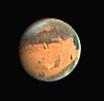
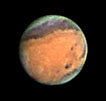

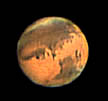
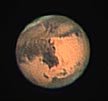
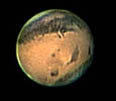 Observing Mars.
Seeing fine details on Mars is best done with color filters.
The maria (dark albedo features) are best observed using a red
or orange filter that will enhance contrast of the maria,
canals and oasis features. Clouds, ice fogs, limb haze and the
polar hoods will best be observed using a blue filter. The
polar hood on the top of these images (south polar cap) are
composed of ice and carbon dioxide crystals. These images of
Mars were taken (from left to right) on 5/14/01 9:22 UT,
05/19/01 8:32 UT , 5/29/01 6:57 06/03/01 7:28 UT and 6/11/01
7:03 UT, 6/20/01 at 6:10 UT, from Houston Texas with a C14 @
f/60 using a ST6 CCD.
Observing Mars.
Seeing fine details on Mars is best done with color filters.
The maria (dark albedo features) are best observed using a red
or orange filter that will enhance contrast of the maria,
canals and oasis features. Clouds, ice fogs, limb haze and the
polar hoods will best be observed using a blue filter. The
polar hood on the top of these images (south polar cap) are
composed of ice and carbon dioxide crystals. These images of
Mars were taken (from left to right) on 5/14/01 9:22 UT,
05/19/01 8:32 UT , 5/29/01 6:57 06/03/01 7:28 UT and 6/11/01
7:03 UT, 6/20/01 at 6:10 UT, from Houston Texas with a C14 @
f/60 using a ST6 CCD.
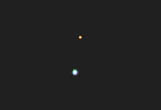 The Double star Gamma in the constellation Lepus.
This wide double star has contrasting colors and is separated by
95 arc seconds. It is about 29 light years from Earth. The
primary star is magnitude 6 and its companion is magnitude 3.5.
Color descriptions of this pair vary considerably and in this
image they appear blue and orange. This image was taken with a
C14 and a ST237 CCD on 3/09/01 from Houston Texas. Exposure
times were R=G=B=.02 seconds.
The Double star Gamma in the constellation Lepus.
This wide double star has contrasting colors and is separated by
95 arc seconds. It is about 29 light years from Earth. The
primary star is magnitude 6 and its companion is magnitude 3.5.
Color descriptions of this pair vary considerably and in this
image they appear blue and orange. This image was taken with a
C14 and a ST237 CCD on 3/09/01 from Houston Texas. Exposure
times were R=G=B=.02 seconds.
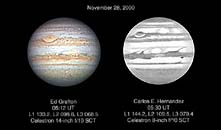 Planetary Drawings. Recording planetary detail is not limited to
film and CCD images. The planetary drawing is a time honored
way of recording details and is the basis of of much amateur
planetary research. Carlos E. Hernandez made this drawing of
Jupiter showing much detail using a 8 inch SCT at 231x
and Wratten 23A (light red) and 64( blue-green) filters. His
observation was made from Florida, USA 11/28/00 at 5:30 UT.
Planetary Drawings. Recording planetary detail is not limited to
film and CCD images. The planetary drawing is a time honored
way of recording details and is the basis of of much amateur
planetary research. Carlos E. Hernandez made this drawing of
Jupiter showing much detail using a 8 inch SCT at 231x
and Wratten 23A (light red) and 64( blue-green) filters. His
observation was made from Florida, USA 11/28/00 at 5:30 UT.
 Planetary Nebula M27 in the Constellation
Vulpecula. The
"Dumbbell" nebula is about 8x5 arc-minutes in size and is
magnitude 8 as seen from earth. It was discovered by Messier
in 1764. The Dumbbell nebula is about 48,000 years old and is
expanding at a rate of 17 miles per second. This image is a
LRGB taken with a C14 and an ST237 CCD @ f/3.6 from Houston,
Texas on 8/6/00. Exposure times are L=R=G=B=8 minutes.
Planetary Nebula M27 in the Constellation
Vulpecula. The
"Dumbbell" nebula is about 8x5 arc-minutes in size and is
magnitude 8 as seen from earth. It was discovered by Messier
in 1764. The Dumbbell nebula is about 48,000 years old and is
expanding at a rate of 17 miles per second. This image is a
LRGB taken with a C14 and an ST237 CCD @ f/3.6 from Houston,
Texas on 8/6/00. Exposure times are L=R=G=B=8 minutes.
 M22 in the Constellation Sagittarius.
M22 was discovered in 1665 by the German astronomer Johann Abraham Ihle . The cluster can be
resolved into hundreds of stars with an 8 inch scope, but it's
actual star count is probably in the hundreds of thousands. M22
has a diameter of about 15 arc minutes and its central
condensation is about 7 arc minutes. At magnitude 6.5, it may
just be visible to the eye under excellent skies. This image of
M22 was taken on 8/5/00 from Houston Texas with a C14 and a
ST237 CCD @ f/3.6. The image is an LRGB with the L constructed
form the RGB images. Exposures were R=G=B=7 minutes.
M22 in the Constellation Sagittarius.
M22 was discovered in 1665 by the German astronomer Johann Abraham Ihle . The cluster can be
resolved into hundreds of stars with an 8 inch scope, but it's
actual star count is probably in the hundreds of thousands. M22
has a diameter of about 15 arc minutes and its central
condensation is about 7 arc minutes. At magnitude 6.5, it may
just be visible to the eye under excellent skies. This image of
M22 was taken on 8/5/00 from Houston Texas with a C14 and a
ST237 CCD @ f/3.6. The image is an LRGB with the L constructed
form the RGB images. Exposures were R=G=B=7 minutes.
 M57 in the Constellation Lyra. the
"Ring Nebula" is the best know example of a planetary nebula. It
was discovered in 1779 by the French astronomer Toulouse. M57 is
illuminated by the blue dwarf star at its center. Its radiation
causes a bright fluorescence in the rarefied gases of the
nebula. M57 is expanding at a rate of 12 miles a second and at
that rate it took 20,000 years to reach its present size, from
its initial expansion. This LRGB image of M57 was taken with a
C14 @ f/5 and a ST237 CCD from Houston, Texas on 8/4/00. The
exposures were L=R=G=B= 7 minutes.
M57 in the Constellation Lyra. the
"Ring Nebula" is the best know example of a planetary nebula. It
was discovered in 1779 by the French astronomer Toulouse. M57 is
illuminated by the blue dwarf star at its center. Its radiation
causes a bright fluorescence in the rarefied gases of the
nebula. M57 is expanding at a rate of 12 miles a second and at
that rate it took 20,000 years to reach its present size, from
its initial expansion. This LRGB image of M57 was taken with a
C14 @ f/5 and a ST237 CCD from Houston, Texas on 8/4/00. The
exposures were L=R=G=B= 7 minutes.
 Globular Cluster M13 is in the Constellation
Hercules. M13 is the finest globular in the
northern sky. It was first mentioned by Halley in 1715. M13 has
a total luminosity of 300,000 suns and has an apparent magnitude
of 6, making it just visible to the eye under dark skies. M13
begins to resolve with a 5 inch scope and with a 10 inch or
larger scope, it is a spectacular object to observe. The red
giants in the image have a luminosity of about 2000 suns. M13 is
about 21,000 light years from Earth and has a diameter of 160
light years. This image is a LRGB with the L image constructed
form the R&G image. The exposure time is R=G=B=10 minutes.
This image was taken with a C14 and a ST237 CCD @ f/3.6 on
6/24/00 from Houston, Texas.
Globular Cluster M13 is in the Constellation
Hercules. M13 is the finest globular in the
northern sky. It was first mentioned by Halley in 1715. M13 has
a total luminosity of 300,000 suns and has an apparent magnitude
of 6, making it just visible to the eye under dark skies. M13
begins to resolve with a 5 inch scope and with a 10 inch or
larger scope, it is a spectacular object to observe. The red
giants in the image have a luminosity of about 2000 suns. M13 is
about 21,000 light years from Earth and has a diameter of 160
light years. This image is a LRGB with the L image constructed
form the R&G image. The exposure time is R=G=B=10 minutes.
This image was taken with a C14 and a ST237 CCD @ f/3.6 on
6/24/00 from Houston, Texas.
 Globular Cluster M5 in the Constellation Serpens.
The star populations WRT brightness and color in a globular
cluster can be represented with a HR (Hertzsprung Russell)
diagram and M5 represents a typical globular cluster. This HR
diagram shows the typical "demographics" of a globular cluster's
star type distribution, and this distribution is referred to as
population II stars. As you can see from the image and the HR
diagram, the population II star distributions consist of red
giants ,blue ,white, and yellow stars. The blue stars on the
horizontal branch are referred to as RR Lyrae stars and consist
of white and blue giants and are spectral class A through F.
These stars oscillate in both absolute magnitude and spectral
class. This image of M5 is an LRGB and was taken from Houston
Texas on 4/28/00 with a C14 @ f/3.8 and a ST237 CCD. The
exposure times were R=G=B=7 minutes. The L channel was derived
from the green and red exposures.
Globular Cluster M5 in the Constellation Serpens.
The star populations WRT brightness and color in a globular
cluster can be represented with a HR (Hertzsprung Russell)
diagram and M5 represents a typical globular cluster. This HR
diagram shows the typical "demographics" of a globular cluster's
star type distribution, and this distribution is referred to as
population II stars. As you can see from the image and the HR
diagram, the population II star distributions consist of red
giants ,blue ,white, and yellow stars. The blue stars on the
horizontal branch are referred to as RR Lyrae stars and consist
of white and blue giants and are spectral class A through F.
These stars oscillate in both absolute magnitude and spectral
class. This image of M5 is an LRGB and was taken from Houston
Texas on 4/28/00 with a C14 @ f/3.8 and a ST237 CCD. The
exposure times were R=G=B=7 minutes. The L channel was derived
from the green and red exposures.
 The Globular Cluster Omega Centaurus.
The finest example of a globular cluster in the sky. This
globular is visible to the naked eye but you will need a
southerly location to view it. Located at a declination of -47
degrees, it barely peeks above the trees in south Texas, Florida
and the desert southwest regions of the USA. This globular is
about 150 light years across and is at a distance of about
20,000 light years. The star density is estimated to be about
25,000 time greater than the star density in the neighborhood of
our star the sun. This image is an RGB taken with a 120mm
refractor at f/4 with a ST237 CCD. Taken from Danciger Texas on
4/8/00. R=G=B=100 seconds.
The Globular Cluster Omega Centaurus.
The finest example of a globular cluster in the sky. This
globular is visible to the naked eye but you will need a
southerly location to view it. Located at a declination of -47
degrees, it barely peeks above the trees in south Texas, Florida
and the desert southwest regions of the USA. This globular is
about 150 light years across and is at a distance of about
20,000 light years. The star density is estimated to be about
25,000 time greater than the star density in the neighborhood of
our star the sun. This image is an RGB taken with a 120mm
refractor at f/4 with a ST237 CCD. Taken from Danciger Texas on
4/8/00. R=G=B=100 seconds.
|
|
Images on Earth
|
|
Techniques and Tips for CCD Imaging
|
|
Visit These Amateur Sites
|
Visit Al Kelly's Astrophotography page for images with a 32 inch and a CB245....Wow! Find out what's new with the Johnson Space Center Astronomical Society. |